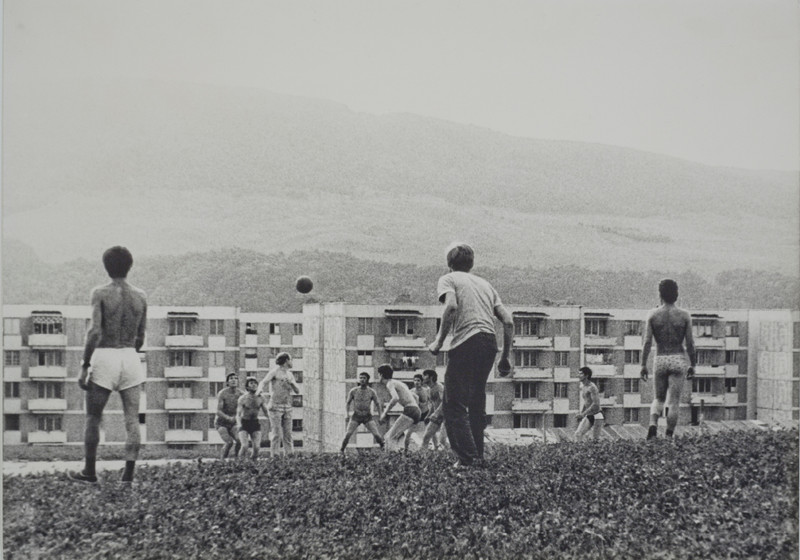ION GRIGORESCU - Afternoon in Piatra Neamt
27 Oct 2012 - 12 Jan 2013
Galerija Gregor Podnar is proud to announce the second solo exhibition of Ion Grigorescu, Afternoon in Piatra Neamt which presents a broad vision of the artist’s photographic production.
The exhibition features a selection of photographs from the ‘70s and ‘80s, as well as more recent works and a group of undeveloped photos printed from old negatives. These latter offer the rare opportunity to see works hitherto un-produced, precious testimonies that enrich and complement the overall trajectory of the artist. Drawings, lithographs, sculptures and the film "Male and Female" (1976) are accompanying the photographic works.
All of the work revolves around the artist himself, his life, the city in which he lives, his clandestine artistic practice and his experiences under totalitarian communism with its restrictions and utopias, all as if the artist were a witness who analyses the time in which lived with an inquisitive eye.
Themes present throughout the work.
Some photos taken of the artist’s private performances portray the body of the artist laying down as a vehicle that consciously experiences and, as an exemplary model, reflects the collective condition. These performances address the complexity of sensorial experience, the passage of time, and the repetition of rituals to the point of exasperation.
From images of the body the exhibition moves to the city and the changes the latter underwent subsequent to Ceauşescu’s utopian dream to construct an ideal Bucharest according to his urban and industrial plans, which included intentions to move entire villages into condominiums in the city and destroy historic buildings.
The documentation of everyday life is not only perceived through urban changes, but can also be seen in images of rural landscapes, poetic still lifes, and portraits of everyday domestic happenings, which act as precious testimonies of collective existence and quotidian situations.
The photographs taken in archives consist of re-photographed images depicting wars, past events, and posed shots assume a more analytical approach toward images, which here become self-reflexive analyses of themselves, as well as reflections on the cyclicality of history.
The former political climate is documented through images of electoral meetings organized by the communist party in the ‘70s, strictly supervised by members of the secret police. These images, which were taken with a hidden camera and in difficult conditions, contain trenchant observations of the Roman dictatorship and the iron fist of the regime. Such a political crisis becomes perceived as an existential crisis and a crisis of the human spirit.
Last but least, there are photos of icons and drawings of saints that testify to a constant spiritual search, to which the artist seeks to gain access through religion, poetry, and dreams.
This exhibition has been made in collaboration with Collegium Hungaricum Berlin. We would like to inform you about the exhibition "Vertigo of Freedom" at Collegium Hungaricum Berlin, curated by Kata Krasznahorkai, including the participation of Ion Grigorescu. (www.kritikundkrise.de)
The exhibition features a selection of photographs from the ‘70s and ‘80s, as well as more recent works and a group of undeveloped photos printed from old negatives. These latter offer the rare opportunity to see works hitherto un-produced, precious testimonies that enrich and complement the overall trajectory of the artist. Drawings, lithographs, sculptures and the film "Male and Female" (1976) are accompanying the photographic works.
All of the work revolves around the artist himself, his life, the city in which he lives, his clandestine artistic practice and his experiences under totalitarian communism with its restrictions and utopias, all as if the artist were a witness who analyses the time in which lived with an inquisitive eye.
Themes present throughout the work.
Some photos taken of the artist’s private performances portray the body of the artist laying down as a vehicle that consciously experiences and, as an exemplary model, reflects the collective condition. These performances address the complexity of sensorial experience, the passage of time, and the repetition of rituals to the point of exasperation.
From images of the body the exhibition moves to the city and the changes the latter underwent subsequent to Ceauşescu’s utopian dream to construct an ideal Bucharest according to his urban and industrial plans, which included intentions to move entire villages into condominiums in the city and destroy historic buildings.
The documentation of everyday life is not only perceived through urban changes, but can also be seen in images of rural landscapes, poetic still lifes, and portraits of everyday domestic happenings, which act as precious testimonies of collective existence and quotidian situations.
The photographs taken in archives consist of re-photographed images depicting wars, past events, and posed shots assume a more analytical approach toward images, which here become self-reflexive analyses of themselves, as well as reflections on the cyclicality of history.
The former political climate is documented through images of electoral meetings organized by the communist party in the ‘70s, strictly supervised by members of the secret police. These images, which were taken with a hidden camera and in difficult conditions, contain trenchant observations of the Roman dictatorship and the iron fist of the regime. Such a political crisis becomes perceived as an existential crisis and a crisis of the human spirit.
Last but least, there are photos of icons and drawings of saints that testify to a constant spiritual search, to which the artist seeks to gain access through religion, poetry, and dreams.
This exhibition has been made in collaboration with Collegium Hungaricum Berlin. We would like to inform you about the exhibition "Vertigo of Freedom" at Collegium Hungaricum Berlin, curated by Kata Krasznahorkai, including the participation of Ion Grigorescu. (www.kritikundkrise.de)

